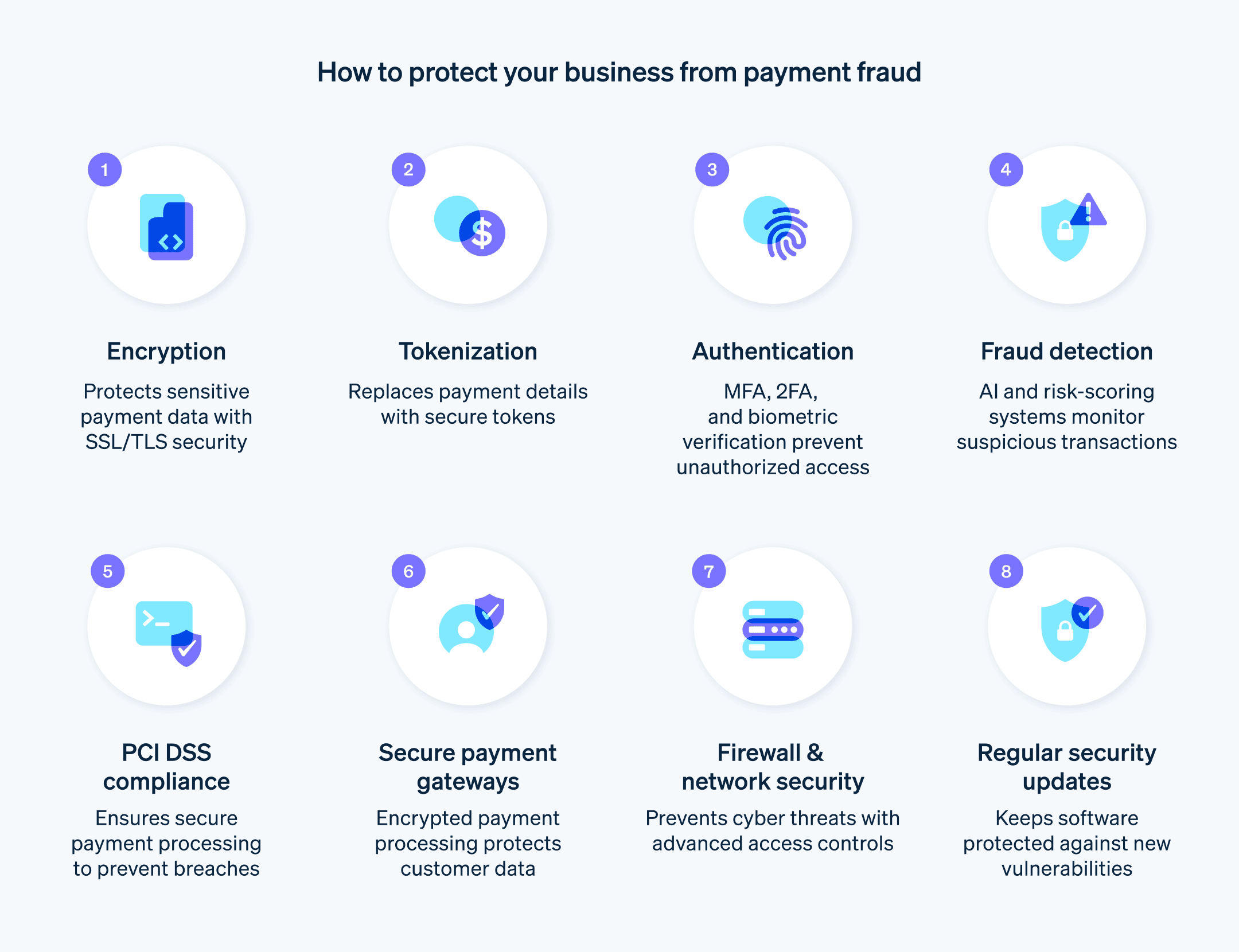ทุกธุรกิจควรคำนึงถึงความปลอดภัยในการชำระเงิน ในปี 2024 องค์กร 79% รายงานว่าตกเป็นเป้าหมายของการฉ้อโกงเกี่ยวกับการชำระเงิน และการฉ้อโกงเกี่ยวกับการชำระเงินก็อาจสร้างความเสียหายได้อย่างไม่น่าเชื่อ โดยการรั่วไหลของข้อมูลโดยเฉลี่ยทั่วโลกมีค่าใช้จ่ายถึง 4.4 ล้านดอลลาร์ ธุรกิจต้องให้ความสำคัญกับความปลอดภัยในการชำระเงินเพื่อปกป้องข้อมูลที่ละเอียดอ่อนของลูกค้า รักษาความไว้วางใจจากลูกค้า และหลีกเลี่ยงการสูญเสียทางการเงินที่มีค่าใช้จ่ายมหาศาล
คู่มือนี้มีขั้นตอนที่นำไปใช้ได้จริงหากต้องการพัฒนาและใช้กลยุทธ์การรักษาความปลอดภัยการชำระเงินที่มีประสิทธิภาพ ไม่ว่าคุณจะเป็นอีคอมเมิร์ซ ผู้ค้าปลีก ร้านที่มีหน้าร้านจริง หรือผู้ให้บริการ SaaS ความสำเร็จของธุรกิจส่วนหนึ่งก็ขึ้นอยู่กับกลยุทธ์การรักษาความปลอดภัยการชำระเงินที่รัดกุม
เนื้อหาหลักในบทความ
- การรักษาความปลอดภัยในการชำระเงินคืออะไร
- หลักการรักษาความปลอดภัยในการชำระเงิน
- ฟีเจอร์ความปลอดภัยที่ควรมองหาเมื่อเลือกผู้ให้บริการการชำระเงิน
- แนวทางปฏิบัติด้านความปลอดภัยที่ดีที่สุดสำหรับธุรกิจ
- Stripe Radar สามารถช่วยได้อย่างไร
การรักษาความปลอดภัยในการชำระเงินคืออะไร
ความปลอดภัยในการชำระเงินหมายถึงระบบ กระบวนการ และมาตรการที่ปกป้องธุรกรรมทางการเงินจากการเข้าถึงที่ไม่ได้รับอนุญาต การเจาะข้อมูล และการฉ้อโกง สำหรับธุรกิจทั้งแบบออนไลน์และแบบมีหน้าร้าน การรับรองความปลอดภัยในการชำระเงินเป็นสิ่งสำคัญหากจะรักษาความเชื่อมั่นของลูกค้า ลดความสูญเสียทางการเงิน และปฏิบัติตามกฎระเบียบและมาตรฐานอุตสาหกรรมที่เกี่ยวข้อง
หลักการรักษาความปลอดภัยในการชำระเงิน
มีหลักการรักษาความปลอดภัยการชำระเงินมากมายที่ทำงานร่วมกันเพื่อปกป้องธุรกรรมทางการเงินและข้อมูลลูกค้า โดยคุณควรรู้สิ่งต่อไปนี้
การเข้ารหัส
การเข้ารหัสจะปกป้องข้อมูลลูกค้าที่ละเอียดอ่อนและธุรกรรมทางการเงินจากการเข้าถึงโดยไม่ได้รับอนุญาต การแทรกแซง และการโจรกรรม การเข้ารหัสหลักมีอยู่สองประเภท นั่นคือ แบบสมมาตรและอสมมาตร การเข้ารหัสแบบสมมาตรจะใช้คีย์เดียวกันในการล็อกและปลดล็อกข้อมูล ในขณะที่การเข้ารหัสแบบอสมมาตร หรือที่เรียกว่า “การเข้ารหัสด้วยคีย์สาธารณะ” ใช้คีย์ 2 อัน ได้แก่ คีย์สาธารณะสำหรับการล็อกและคีย์ส่วนตัวสำหรับการปลดล็อกข้อมูล โดยทั่วไปแล้ว การเข้ารหัสแบบสมมาตรจะถือว่ามีความปลอดภัยมากกว่า เนื่องจากไม่มีการใช้คีย์ส่วนตัวร่วมกัน
ธุรกิจต่างๆ ใช้โปรโตคอลการเข้ารหัส เช่น Secure Sockets Layer (SSL) และ Transport Layer Security (TLS) เพื่อรักษาความปลอดภัยในการรับส่งข้อมูลระหว่างเบราว์เซอร์ของลูกค้ากับเว็บไซต์ธุรกิจหรือแพลตฟอร์มการชำระเงิน การเข้ารหัส SSL/TLS นั้นจะใช้การผสมผสานระหว่างการเข้ารหัสแบบสมมาตรและแบบอสมมาตรเพื่อสร้างการเชื่อมต่อที่ปลอดภัยและปกป้องข้อมูลระหว่างการส่งข้อมูล
การแปลงเป็นโทเค็น
การแปลงเป็นโทเค็นจะปกป้องข้อมูลการชำระเงินที่ละเอียดอ่อน โดยแทนที่ข้อมูลด้วยโทเค็นที่ไม่ซ้ำกันซึ่งไม่มีมูลค่าที่แท้จริงหากถูกบุกรุก วิธีนี้ช่วยลดความเสี่ยงของการเข้าถึงโดยไม่ได้รับอนุญาตและการละเมิดข้อมูลได้เป็นอย่างดี รวมถึงรักษาการปฏิบัติตามข้อกำหนดมาตรฐานและข้อบังคับของอุตสาหกรรมด้วยเช่นกัน
การแปลงการชำระเงินเป็นโทเค็นจะแทนที่ข้อมูลที่ละเอียดอ่อน เช่น หมายเลขบัตรเครดิต ด้วยโทเค็นเฉพาะที่สร้างโดยระบบที่ปลอดภัย ระบบจะใช้โทเค็นเหล่านี้เพื่ออ้างอิงข้อมูลการชำระเงินเดิมซึ่งอยู่ในตู้นิรภัยสำหรับจัดเก็บโทเค็นทั้งหมด โทเค็นนั้นไม่สามารถใช้ทำธุรกรรมฉ้อโกงหรือถอดรหัสย้อนกลับเพื่อเปิดเผยข้อมูลการชำระเงินเดิมได้
การตรวจสอบสิทธิ์
การตรวจสอบสิทธิ์เป็นมาตรการรักษาความปลอดภัยพื้นฐานสำหรับการชำระเงิน ซึ่งจะยืนยันตัวตนของผู้ใช้ที่พยายามเข้าถึงหรือทำธุรกรรมให้เสร็จสมบูรณ์
การตรวจสอบสิทธิ์มีหลายประเภทดังต่อไปนี้
- การตรวจสอบสิทธิ์แบบปัจจัยเดียว (SFA): ต้องระบุข้อมูลประจำตัวรูปแบบใดรูปแบบหนึ่ง ซึ่งปกติแล้วจะเป็นรหัสผ่านหรือ PIN
- การตรวจสอบสิทธิ์แบบ 2 ปัจจัย (2FA): ต้องใช้เอกสารประจำตัว 2 รูปแบบ เช่น รหัสผ่านและรหัสแบบใช้ครั้งเดียวซึ่งส่งไปยังอุปกรณ์ที่ลงทะเบียน
- การตรวจสอบสิทธิ์แบบหลายปัจจัย (MFA): ต้องใช้ข้อมูลประจำตัวอย่างน้อย 3 รูปแบบ ซึ่งอาจประกอบด้วยข้อมูลไบโอเมตริก คำถามรักษาความปลอดภัย หรือโทเค็นจริง
การตรวจจับและการป้องกันการฉ้อโกง
ระบบเหล่านี้ช่วยให้ธุรกิจระบุและป้องกันธุรกรรมที่เป็นการฉ้อโกงโดยการตรวจสอบรูปแบบธุรกรรม พฤติกรรมลูกค้า และปัจจัยเสี่ยงอื่นๆ เทคนิคต่างๆ เช่น อัลกอริทึมแมชชีนเลิร์นนิ่ง การวิเคราะห์พฤติกรรม และการให้คะแนนความเสี่ยงสามารถตรวจจับความผิดปกติและป้องกันการฉ้อโกงได้ โปรดดูรายละเอียดเพิ่มเติมที่คู่มือการตรวจจับการฉ้อโกง
การปฏิบัติตามมาตรฐานการรักษาความปลอดภัยข้อมูลสำหรับอุตสาหกรรมบัตรชำระเงิน
มาตรฐานการรักษาความปลอดภัยข้อมูลสำหรับอุตสาหกรรมบัตรชำระเงิน (PCI DSS) คือชุดมาตรฐานการรักษาความปลอดภัยซึ่งออกแบบมาเพื่อรับรองว่าธุรกิจทุกแห่งที่ดำเนินการ จัดเก็บ หรือส่งข้อมูลบัตรเครดิตจะรักษาสภาพแวดล้อมที่ปลอดภัย การปฏิบัติตามข้อกำหนดของ PCI DSS จะช่วยปกป้องข้อมูลที่ละเอียดอ่อนของลูกค้าและลดความเสี่ยงที่จะเกิดการละเมิดข้อมูล
การบรรลุและรักษาการปฏิบัติตามข้อกำหนด PCI DSS เป็นสิ่งสำคัญในการปกป้องข้อมูลการชำระเงินที่ละเอียดอ่อนของลูกค้า และแสดงให้เห็นถึงความมุ่งมั่นในการรักษาความปลอดภัย
เกตเวย์ชำระเงิน
เกตเวย์การชำระเงินช่วยอำนวยความสะดวกในการประมวลผลธุรกรรมบัตรในขณะที่ปกป้องข้อมูลการชำระเงินของลูกค้าไม่ให้ถูกเข้าถึงโดยไม่ได้รับอนุญาตและถูกฉ้อโกง ด้วยการกำหนดช่องทางที่ปลอดภัยให้กับการส่งข้อมูลการชำระเงินระหว่างลูกค้า ธุรกิจ และผู้ประมวลผลการชำระเงิน หรือธนาคารที่รับข้อมูล เกตเวย์การชำระเงินจึงเป็นองค์ประกอบสำคัญของสภาพแวดล้อมการชำระเงินที่มีความปลอดภัยสูง
ไฟร์วอลล์และการรักษาความปลอดภัยของเครือข่าย
ไฟร์วอลล์และการรักษาความปลอดภัยของเครือข่ายจะช่วยปกป้องระบบการชำระเงินและข้อมูลลูกค้าที่เป็นความลับจากภัยคุกคามภายนอก เช่น แฮ็กเกอร์ มัลแวร์ และผู้ประสงค์ร้ายอื่นๆ
ไฟร์วอลล์เป็นระบบรักษาความปลอดภัยประเภทหนึ่งที่ทำหน้าที่คล้ายกับมาตรการรักษาความปลอดภัยสำหรับเครือข่ายคอมพิวเตอร์ โดยจะควบคุมข้อมูลขาเข้าและขาออกโดยอิงตามกฎเฉพาะ ไฟร์วอลล์สร้างกำแพงป้องกันระหว่างเครือข่ายที่เชื่อถือได้ภายในธุรกิจ เช่น ระบบการชำระเงิน และโลกภายนอกที่ไม่น่าเชื่อถือ เช่น อินเทอร์เน็ต โดยช่วยป้องกันการเข้าถึงเครือข่ายที่ไม่ได้รับอนุญาต ไฟร์วอลล์อาจเป็นฮาร์ดแวร์ ซอฟต์แวร์ หรือทั้งสองอย่างประกอบกัน
ประเด็นสำคัญของไฟร์วอลล์และความปลอดภัยของเครือข่าย ได้แก่
การแบ่งส่วนเครือข่าย
การแบ่งเครือข่ายออกเป็นส่วนย่อยๆ ที่แยกกันจะช่วยจำกัดความเสียหายที่อาจเกิดขึ้นจากการละเมิดความปลอดภัย การเก็บข้อมูลและระบบการชำระเงินที่ละเอียดอ่อนไว้ในกลุ่มเครือข่ายที่แยกจากกัน ช่วยให้ธุรกิจสามารถปกป้องสินทรัพย์เหล่านี้จากการเข้าถึงโดยไม่ได้รับอนุญาตได้ดีขึ้น และลดภาระงานในการปฏิบัติตามมาตรฐาน PCI DSS ลงได้ระบบตรวจจับและป้องกันการบุกรุก (IDPS)
โซลูชัน IDPS จะตรวจสอบการใช้งานในเครือข่ายเพื่อหากิจกรรมที่น่าสงสัย ตรวจจับภัยคุกคามที่อาจเกิดขึ้น และดำเนินการเพื่อป้องกันหรือลดภัยคุกคามเหล่านั้น เมื่อใช้วิธีการต่างๆ ร่วมกัน เช่น การตรวจสอบภัยคุกคามที่รู้จักและการวิเคราะห์กฎการสื่อสาร โซลูชัน IDPS จะสามารถระบุและบล็อกการโจมตีได้หลายประเภท แม้แต่การโจมตีรูปแบบใหม่ๆ ก็ตามการควบคุมการเข้าถึงที่รัดกุม
การควบคุมการเข้าถึง เช่น การยืนยันตัวตนหลายปัจจัย (MFA) การควบคุมการเข้าถึงตามบทบาท (RBAC) และ “หลักการสิทธิ์ขั้นต่ำสุด” ซึ่งเป็นแนวทางปฏิบัติในการให้สิทธิ์การเข้าถึงขั้นต่ำแก่บุคคลหรือหน่วยงานในการดำเนินการงานหรือหน้าที่เฉพาะที่เกี่ยวข้องกับการประมวลผลการชำระเงิน ช่วยให้มั่นใจได้ว่าผู้ใช้ที่ได้รับอนุญาตเท่านั้นที่จะเข้าถึงทรัพยากรเครือข่ายและระบบการชำระเงินที่ละเอียดอ่อนได้การติดตามตรวจสอบและรับมือกับเหตุการณ์ด้านความปลอดภัย
การตรวจสอบกิจกรรมเครือข่ายอย่างต่อเนื่อง ควบคู่ไปกับแผนการตอบสนองต่อเหตุการณ์ที่เกิดขึ้นอย่างชัดเจน ช่วยให้ธุรกิจระบุและตอบสนองต่อภัยคุกคามด้านความปลอดภัยได้อย่างรวดเร็ว ทำให้ลดความเสียหายและระยะเวลาหยุดทำงานที่อาจเกิดขึ้นให้เหลือน้อยที่สุด
การอัปเดตการรักษาความปลอดภัยและแพตช์
ผู้จำหน่ายซอฟต์แวร์ ผู้ผลิตฮาร์ดแวร์ และผู้ให้บริการระบบปฏิบัติการจะเผยแพร่การอัปเดตความปลอดภัยและแพตช์เพื่อแก้ไขช่องโหว่ ข้อบกพร่อง หรือปัญหาด้านความปลอดภัยอื่นๆ ที่ทราบในผลิตภัณฑ์ของตน การอัปเดตและแพตช์ความปลอดภัยเป็นประจำจะช่วยปกป้องโครงสร้างพื้นฐานการชำระเงิน ข้อมูลลูกค้า และระบบหลักอื่นๆ จากการตกเป็นเหยื่อ การโจมตีทางไซเบอร์ และการเข้าถึงโดยไม่ได้รับอนุญาต
การใช้การอัปเดตและแพตช์เหล่านี้เป็นประจำจะช่วยเรื่องต่อไปนี้
แก้ไขช่องโหว่
การอัปเดตและแพตช์ช่วยแก้ไขข้อบกพร่องด้านความปลอดภัยหรือจุดอ่อนที่แฮ็กเกอร์สามารถนำไปใช้เพื่อเข้าถึงระบบของคุณโดยไม่ได้รับอนุญาตหรือขโมยข้อมูลที่ละเอียดอ่อน ดังนั้น การอัปเดตแพตช์ความปลอดภัยอยู่เสมอจะช่วยลดความเสี่ยงในการละเมิดข้อมูลและการโจมตีทางไซเบอร์ได้ปรับปรุงประสิทธิภาพ
การอัปเดตมักรวมถึงการเพิ่มประสิทธิภาพ การแก้ไขข้อบกพร่อง หรือฟีเจอร์ใหม่ๆ ที่สามารถปรับปรุงความเสถียรโดยรวม ประสิทธิผล และการทำงานของระบบและซอฟต์แวร์ของคุณดูแลการปฏิบัติตามข้อกำหนด
ข้อกำหนดด้านกฎระเบียบมักเป็นกำหนดให้ธุรกิจใช้การอัปเดตและแพตช์ความปลอดภัยอย่างทันท่วงทีเพื่อรักษาการปฏิบัติตามข้อกำหนด การอัปเดตระบบของคุณเป็นประจำสามารถช่วยให้คุณหลีกเลี่ยงค่าปรับหรือบทลงโทษที่เกี่ยวข้องกับการไม่ปฏิบัติตามข้อกำหนดได้ป้องกันภัยคุกคามที่เกิดขึ้นใหม่
ภัยคุกคามทางไซเบอร์เปลี่ยนแปลงไปเรื่อยๆ เมื่อแฮ็กเกอร์ค้นพบช่องโหว่และพัฒนาเทคนิคการโจมตีแบบใหม่ๆ การใช้การอัปเดตและแพตช์จะช่วยให้คุณก้าวนำหน้ากับภัยคุกคามที่กำลังเกิดขึ้นเหล่านี้และรักษาสภาพแวดล้อมที่ปลอดภัยไว้ได้

ฟีเจอร์ความปลอดภัยที่ควรมองหาเมื่อเลือกผู้ให้บริการการชำระเงิน
เมื่อเลือกผู้ให้บริการการชำระเงิน มีหลายสิ่งที่ต้องพิจารณา ตั้งแต่ฟีเจอร์ด้านความปลอดภัย การปฏิบัติตามข้อกำหนด ไปจนถึงระยะเวลาให้บริการและความน่าเชื่อถือ
ฟีเจอร์หลักที่ควรมองหาเมื่อเลือกผู้ให้บริการการชำระเงินมีดังนี้
การเข้ารหัส
ผู้ให้บริการการชำระเงินที่ปลอดภัยควรใช้โปรโตคอลการเข้ารหัสเพื่อเข้ารหัสข้อมูลการชำระเงินที่ละเอียดอ่อน โปรโตคอลเหล่านี้ช่วยให้มั่นใจได้ว่ารายละเอียดการชำระเงินของลูกค้าจะปลอดภัยระหว่างการส่งข้อมูล ซึ่งเป็นการปกป้องข้อมูลจากการสกัดกั้นหรือการดัดแปลงการแปลงเป็นโทเค็น
ข้อมูลการชำระเงิน เช่น รายละเอียดของบัตรควรถูกแปลงเป็นโทเค็นเพื่อปกป้องข้อมูลลูกค้า ลดความเสี่ยงของการละเมิดข้อมูล และปฏิบัติตามข้อกำหนด PCI DSSการตรวจสอบสิทธิ์และการป้องกันการฉ้อโกง
สร้างวิธีการรับรองความถูกต้อง เช่น การตรวจสอบ CVV/CVC, การรักษาความปลอดภัยแบบ 3D และการรับรองความถูกต้องด้วยไบโอเมตริกซ์ เพื่อยืนยันตัวตนลูกค้าและป้องกันธุรกรรมที่ไม่ได้รับอนุญาต นอกจากนี้ ตรวจสอบว่าลูกค้าใช้ระบบสำหรับการตรวจจับและป้องกันการฉ้อโกงขั้นสูงที่ใช้แมชชีนเลิร์นนิง การวิเคราะห์พฤติกรรม และการให้คะแนนความเสี่ยงเพื่อระบุและปิดกั้นธุรกรรมที่เป็นการฉ้อโกงแบบเรียลไทม์การปฏิบัติตามมาตรฐานอุตสาหกรรม
ผู้ให้บริการควรปฏิบัติตาม PCI DSS และมาตรฐานอุตสาหกรรมอื่นๆ ที่เกี่ยวข้องเพื่อรักษาสภาพแวดล้อมที่ปลอดภัยสำหรับการประมวลผล จัดเก็บ และส่งข้อมูลเจ้าของบัตรระยะเวลาให้บริการและความเสถียร
การรักษาระยะเวลาให้บริการและความน่าเชื่อถือให้อยู่ในระดับสูงช่วยให้มั่นใจได้ว่าลูกค้าสามารถทำธุรกรรมให้เสร็จสมบูรณ์ได้โดยไม่หยุดชะงัก การตรวจสอบอย่างสม่ำเสมอ มาตรการซ้ำซ้อน และโครงสร้างพื้นฐานที่แข็งแกร่งช่วยให้ผู้ให้บริการสามารถประมวลผลธุรกรรมได้อย่างปลอดภัยและมีประสิทธิภาพ
แนวทางปฏิบัติด้านความปลอดภัยที่ดีที่สุดสำหรับธุรกิจ
ธุรกิจทั้งหมดที่ประมวลผล จัดเก็บ หรือส่งข้อมูลการชำระเงิน รวมถึงข้อมูลบัตร จำเป็นต้องคำนึงถึงความปลอดภัยในการชำระเงิน การรักษากระบวนการการชำระเงินที่ปลอดภัยเป็นสิ่งสำคัญสำหรับการปกป้องข้อมูลลูกค้าที่ละเอียดอ่อน ทำให้มั่นใจลูกค้าความน่าเชื่อถือ และปฏิบัติตามมาตรฐานและข้อบังคับของอุตสาหกรรม สำหรับธุรกิจทุกขนาดและในทุกอุตสาหกรรม
เพื่อให้แน่ใจว่ามีคู่มือที่รอบคอบสำหรับจัดการความปลอดภัยเกี่ยวกับการชำระเงิน ธุรกิจควรทำตามขั้นตอนต่อไปนี้
1. ประเมินความเสี่ยง
เริ่มต้นด้วยการพิจารณาโครงสร้างพื้นฐาน กระบวนการ และระบบการชำระเงินปัจจุบันของคุณ เพื่อระบุจุดอ่อนที่อาจเกิดขึ้นและจุดที่ต้องปรับปรุง กำหนดประเภทข้อมูลที่ละเอียดอ่อนที่ธุรกิจของคุณจัดการ รวมทั้งดูว่าข้อมูลนั้นถูกจัดเก็บ ประมวลผล และส่งไปที่ใด
2. ทำความเข้าใจข้อกำหนดในการปฏิบัติตามกฎระเบียบต่างๆ
ทำความคุ้นเคยกับมาตรฐานและข้อบังคับที่ควบคุมอุตสาหกรรมของคุณ รวมถึง PCI DSS และกำหนดข้อกำหนดการปฏิบัติตามข้อกำหนดเฉพาะของธุรกิจที่จัดตั้งขึ้นตามตลาดที่คุณดำเนินธุรกิจ ตรวจสอบว่าคุณเข้าใจการควบคุมและแนวทางปฏิบัติด้านความปลอดภัยที่กำหนดโดยมาตรฐานเหล่านี้ ฝึกอบรมพนักงานเกี่ยวกับข้อกำหนด PCI DSS และแนวทางปฏิบัติที่ดีที่สุดสำหรับการจัดการข้อมูลเจ้าของบัตรอย่างปลอดภัย
3. พัฒนานโยบายและขั้นตอนปฏิบัติด้านความปลอดภัย
กำหนดนโยบายและขั้นตอนที่ชัดเจนซึ่งจัดการกับความปลอดภัยของการชำระเงิน เช่น แนวทางในการจัดการข้อมูลที่ละเอียดอ่อน การควบคุมการเข้าถึง การตอบสนองต่อเหตุการณ์ การจัดการแพตช์ และการฝึกอบรมพนักงาน รวมถึงตรวจสอบว่านโยบายและขั้นตอนเหล่านี้สอดคล้องกับมาตรฐานและข้อบังคับของอุตสาหกรรม
4. นำมาตรการรักษาความปลอดภัยไปใช้
หลังจากประเมินความเสี่ยงและข้อกำหนดการปฏิบัติตามข้อกำหนดของคุณแล้ว ให้เริ่มใช้มาตรการรักษาความปลอดภัยที่เหมาะสม เช่น การเข้ารหัส การแปลงเป็นโทเค็น การรับรองความถูกต้องที่รัดกุม และการกำหนดค่าไฟร์วอลล์ เลือกผู้ให้บริการการชำระเงินที่ปลอดภัยและทำงานร่วมกับผู้ให้บริการที่ปฏิบัติตาม PCI DSS เพื่อให้ปฏิบัติตามตามข้อกำหนดได้สะดวกสบายขึ้น
5. ตรวจสอบระบบและทำการทดสอบความทนทาน
ตรวจสอบระบบ เครือข่าย และแอปพลิเคชันการชำระเงินของคุณอย่างสม่ำเสมอเพื่อหาภัยคุกคามหรือช่องโหว่ที่อาจเกิดขึ้น กลยุทธ์ต่างๆ เช่น การสแกนช่องโหว่ การทดสอบการเจาะระบบ และการตรวจสอบระบบสามารถประเมินประสิทธิภาพของมาตรการรักษาความปลอดภัยของคุณและระบุจุดที่ต้องปรับปรุงได้ นอกจากนี้ ให้พิจารณาใช้เครื่องมืออัตโนมัติที่สามารถช่วยระบุแพตช์ที่ขาดหายไปหรือซอฟต์แวร์ที่ล้าสมัย
6. ปรับวิธีการของคุณตามข้อมูลที่ระบุ
แม้แต่กลยุทธ์การรักษาความปลอดภัยที่วางแผนไว้อย่างดีที่สุดก็จำเป็นต้องได้รับการปรับปรุงและปรับเปลี่ยนตามกาลเวลา ประเมินประสิทธิภาพของกลยุทธ์ด้านการรักษาความปลอดภัยด้านการชำระเงินอย่างต่อเนื่อง และปรับตามความจำเป็นเพื่อจัดการกับการเปลี่ยนแปลงของธุรกิจ ข้อบังคับของอุตสาหกรรม หรือสถานการณ์คุกคามต่างๆ การตรวจสอบเป็นประจำจะช่วยให้มั่นใจได้ว่ากลยุทธ์ของคุณยังคงมีความเกี่ยวข้องและมีประสิทธิผลในการปกป้องข้อมูลของลูกค้าของคุณ
7. สร้างแผนรับมือกับเหตุการณ์
จัดทำแผนรับมือกับปัญหาที่ชัดเจนเพื่อแนะนำองค์กรของคุณในกรณีที่มีการละเมิดการรักษาความปลอดภัยหรือเหตุการณ์อื่นๆ แผนนี้ควรระบุบทบาทและความรับผิดชอบ ระเบียบการการสื่อสาร และระเบียบวิธีในการจำกัดและบรรเทาเหตุการณ์
Stripe Radar สามารถช่วยได้อย่างไร
Stripe Radar ฝึกโมเดล AI เพื่อตรวจจับและป้องกันการฉ้อโกง โดยใช้ข้อมูลจากเครือข่าย Stripe ทั่วโลก ซึ่งจะอัปเดตโมเดลเหล่านี้อย่างต่อเนื่องตามแนวโน้มการฉ้อโกงล่าสุด เพื่อปกป้องธุรกิจของคุณให้ทันตามการฉ้อโกงที่วิวัฒนาการต่อเนื่อง
Stripe ยังมี Radar for Fraud Teams ซึ่งช่วยให้ผู้ใช้เพิ่มกฎที่กำหนดเองเพื่อจัดการกับสถานการณ์การฉ้อโกงเฉพาะสำหรับธุรกิจของตนและเข้าถึงข้อมูลเชิงลึกเกี่ยวกับการฉ้อโกงที่ล้ำสมัย
Radar สามารถช่วยธุรกิจของคุณได้ดังนี้
- ป้องกันการสูญเสียจากการฉ้อโกง: Stripe ประมวลผลการชำระเงินมากกว่า 1 ล้านล้านดอลลาร์ต่อปี ขนาดนี้ช่วยให้ Radar ตรวจจับและป้องกันการฉ้อโกงได้อย่างแม่นยำ ช่วยประหยัดเงินให้คุณ
- เพิ่มรายรับ: โมเดล AI ของ Radar ได้รับการฝึกฝนจากข้อมูลข้อโต้แย้งจริง ข้อมูลลูกค้า ข้อมูลการเรียกดู และอื่นๆ ซึ่งทำให้ Radar สามารถระบุธุรกรรมที่มีความเสี่ยงและลดผลลัพธ์บวกปลอม ส่งผลให้รายได้ของคุณเพิ่มขึ้น
- ประหยัดเวลา: Radar ถูกสร้างขึ้นใน Stripe และไม่ต้องใช้โค้ดในการตั้งค่า คุณยังสามารถตรวจสอบประสิทธิภาพการจัดการการฉ้อโกง เขียนกฎ และอื่นๆ อีกมากมายได้ในแพลตฟอร์มเดียว ซึ่งจะช่วยเพิ่มประสิทธิภาพ
อ่านเพิ่มเติมเกี่ยวกับ Stripe Radar หรือเริ่มใช้งานวันนี้
เนื้อหาในบทความนี้มีไว้เพื่อให้ข้อมูลทั่วไปและมีจุดประสงค์เพื่อการศึกษาเท่านั้น ไม่ควรใช้เป็นคําแนะนําทางกฎหมายหรือภาษี Stripe ไม่รับประกันหรือรับประกันความถูกต้อง ความสมบูรณ์ ความไม่เพียงพอ หรือความเป็นปัจจุบันของข้อมูลในบทความ คุณควรขอคําแนะนําจากทนายความที่มีอํานาจหรือนักบัญชีที่ได้รับใบอนุญาตให้ประกอบกิจการในเขตอํานาจศาลเพื่อรับคําแนะนําที่ตรงกับสถานการณ์ของคุณ